八年级英语上 代词教案人教版
初中英语代词教案

初中英语代词教案教案主题:初中英语代词教学目标:1.理解代词的定义与作用;2.掌握常见的代词及其用法;3.进一步提高学生的英语阅读和写作能力。
教学重点:1.加深学生对代词的理解;2.学会正确运用代词。
教学难点:学生能够正确运用各种代词进行口头表达和书面表达。
教学准备:1.教师准备:PPT、单词卡片、课件;2.学生准备:课本。
教学流程:Step 1:导入(5分钟)出示单词卡片,让学生根据图片或示例,猜测单词的意思,并补充相关的代词。
Step 2:知识讲解(10分钟)讲解代词的定义和作用,并列举常见的代词。
重点讲解人称代词、物主代词、指示代词和不定代词的用法。
Step 3:练习(15分钟)1.随堂小练:根据句子意思,选择恰当的代词填空。
2.完成课本上的代词练习。
Step 4:扩展训练(15分钟)要求学生以小组为单位,选取一篇短文进行阅读,并用代词替换出现的名词或名词短语。
最后交流、分享答案。
Step 5:巩固与拓展(10分钟)教师指导学生完成一些小组活动,如对话或写作,要求学生使用代词进行交流和表达。
Step 6:课堂总结(5分钟)总结本节课所学的代词知识,并强调重点和难点。
Step 7:作业布置(5分钟)要求学生预习下一课的内容,并完成相应的练习。
Step 8:课堂点评(5分钟)对学生的表现给予点评,并提出改进建议。
教学反思:本节课通过导入、知识讲解、练习、扩展训练等环节,使学生逐渐掌握代词的使用方法,并能够运用代词进行交流和表达。
需要注意的是,教师应引导学生灵活运用代词,并鼓励他们在口语和写作中多多使用代词,提高语言表达能力。
八年级上册英语教案 人教版八年级英语教案

八年级上册英语教案人教版八年级英语教案【篇一】八年级上册英语教案2022年新目标英语八年级上全册教案2022年下期八年级英语全册教案(人教版)Unit 1 Where did you go on vacation?Section A 1 (1a-2d)一、教学目标:1. 语言知识目标:1) 能掌握以下单词:anyone, anywhere, wonderful, quite a few, most, something, nothing, everyone, of course, myself, yourself能掌握以下句型:① —Where did you go on vacation? —I went to the mountains.② —Where did Tina to on vacation? —She went to the beach.③ —Did you go with anyone?2) 能了解以下语法:—复合不定代词someone, anyone, something, anything等的用法。
—yourself, myself等反身代词的用法。
3)一般过去时态的特殊疑问句,一般疑问句及其肯定、否定回答。
2. 情感态度价值观目标:学会用一般过去时进行信息交流,培养学生的环保意识,热爱大自然。
二、教学重难点1. 教学重点:1) 用所学的功能语言交流假期去了什么旅行。
2) 掌握本课时出现的新词汇。
2. 教学难点:1) 复合不定代词someone, anyone, something, anything等的用法。
2) yourself, myself等反身代词的用法。
三、教学过程Ⅰ. Lead-in1. 看动画片来进入本课时的主题谈论上周末做了些什么事情,谈论过去发生的事情。
Ⅱ. Presentation1. Show some pictures on the big screen. Let Ss read the expressions.2. Focus attention on the picture. Ask: What can you see? Say: Each picture shows —Yes, I did./No, I didn’t.something a person did in the past. Name each activity and ask students to repeat: Stayed at home, Went to mountains, went to New York City 6. Went to the beach, visited my uncle, visited museums, went to summer camp3. Now, please match each phrase with one of the pictures next to the name of the activity,point to the sample answer.4. Check the answers. Answers: 1. f 2. b 3. g 4. e5. c6. a7. d III. Listening1. Point to the picture on the screen.Say: Look at the picture A. Where did Tina go on vacation? She went to mountains. Ask: What did the person do in each picture?2. Play the recording the first time.3. Play the recording a second time.Say: There are three conversations. The people talk about what did on vacation. Listen to the recording and write numbers of the namesin the right boxes of the picture.4. Check the answers.IV.Pair work1. Point out the sample conversation. Ask two Ss to read the conversation to the class.2. Now work with a partner. Make your own conversation about the people in the picture.3. Ss work in pairs. As they talk, move around the classroom and give any help they need.4. Let some pairs act out their conversations.V. Listening1. Tell Ss they will hear a conversation about three students’ conversations. Listen for the first time and fill in the chart. Then listen again and check Yes, or No.2. Let Ss read the phrases in the chart of 2b.3. Play the recording the first time. Ss listen and fill in the chart.4. Play the recording a second time for the Ss to check “Yes, I did.” or “No, I didn’t. ”5. Check the answers with the Ss.VI. Pair work1. Let two Ss read the conversation between Grace, Kevin and Julie.2. Let Ss work in pairs and try to role-play the conversation.3. Ask some pairs to act out their conversations.VII. Role-play1. First let Ss read the conversation and match the people and places they went.2. Let Ss act out the conversations in pairs.3. Some explanations in 2d.Homework:用英语询问你的一位好朋友,她(他)假期去了哪里?看到了什么?并将此对话写在作业上。
(完整版)初中英语代词教案
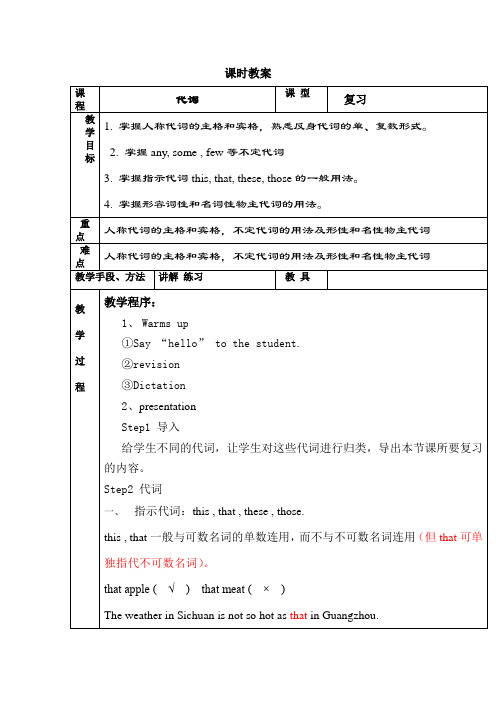
4.(all) by oneself(完全)独立地
5.help oneself to请自便;随便吃…
6.look after oneself自理;照顾自己
7.leave one by oneself把…单独留下
8.lose oneself in陶醉于…;沉浸于…
三、不定代词
1)some与any的用法
Step2代词
一、指示代词:this , that , these , those.
this , that一般与可数名词的单数连用,而不与不可数名词连用(但that可单独指代不可数名词)。
that apple ( √ ) that meat ( × )
The weather inSichuanis not so hot asthatinGuangzhou.
①.____ student in the class likes English.
②.___ of the students studied hard.
人教版中考英语专题复习《代词专题》教学设计
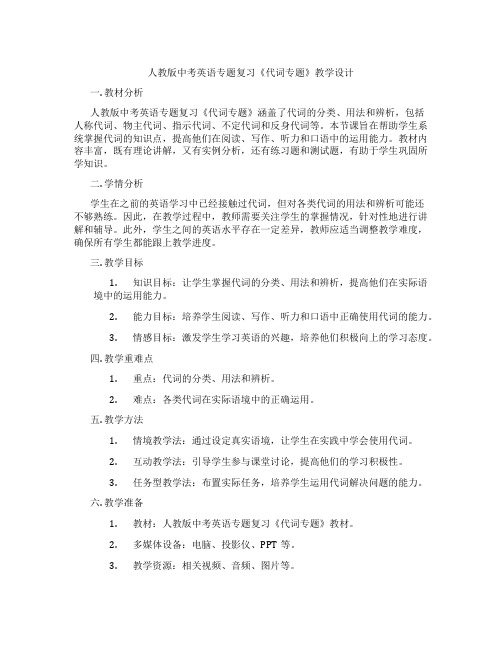
人教版中考英语专题复习《代词专题》教学设计一. 教材分析人教版中考英语专题复习《代词专题》涵盖了代词的分类、用法和辨析,包括人称代词、物主代词、指示代词、不定代词和反身代词等。
本节课旨在帮助学生系统掌握代词的知识点,提高他们在阅读、写作、听力和口语中的运用能力。
教材内容丰富,既有理论讲解,又有实例分析,还有练习题和测试题,有助于学生巩固所学知识。
二. 学情分析学生在之前的英语学习中已经接触过代词,但对各类代词的用法和辨析可能还不够熟练。
因此,在教学过程中,教师需要关注学生的掌握情况,针对性地进行讲解和辅导。
此外,学生之间的英语水平存在一定差异,教师应适当调整教学难度,确保所有学生都能跟上教学进度。
三. 教学目标1.知识目标:让学生掌握代词的分类、用法和辨析,提高他们在实际语境中的运用能力。
2.能力目标:培养学生阅读、写作、听力和口语中正确使用代词的能力。
3.情感目标:激发学生学习英语的兴趣,培养他们积极向上的学习态度。
四. 教学重难点1.重点:代词的分类、用法和辨析。
2.难点:各类代词在实际语境中的正确运用。
五. 教学方法1.情境教学法:通过设定真实语境,让学生在实践中学会使用代词。
2.互动教学法:引导学生参与课堂讨论,提高他们的学习积极性。
3.任务型教学法:布置实际任务,培养学生运用代词解决问题的能力。
六. 教学准备1.教材:人教版中考英语专题复习《代词专题》教材。
2.多媒体设备:电脑、投影仪、PPT等。
3.教学资源:相关视频、音频、图片等。
4.练习题和测试题:用于巩固和检测学生学习效果。
七. 教学过程1.导入(5分钟)利用图片或视频引导学生复习代词的知识点,激发学生的学习兴趣。
例如,展示一组图片,让学生猜测图片中的人物是谁,从而引出人称代词的概念。
2.呈现(10分钟)讲解代词的分类、用法和辨析。
通过PPT展示各类代词的定义和例子,让学生清晰地了解每个代词的用法。
3.操练(10分钟)设置情境,让学生在实践中学会使用代词。
初中英语代词教案模板

教学目标:1. 知识目标:学生能够掌握英语中常见的代词(如I, you, he, she, it, we, they, this, that, these, those)的用法和意义。
2. 能力目标:学生能够正确运用代词进行口语和书面表达。
3. 情感目标:培养学生对英语学习的兴趣,提高学生的英语交际能力。
教学重点:1. 代词的分类和基本用法。
2. 代词在句子中的正确位置和功能。
教学难点:1. 不同代词之间的区别和联系。
2. 代词在复杂句子中的运用。
教学准备:1. 多媒体课件,包括代词图片、例句和练习题。
2. 练习题纸。
3. 小组讨论活动所需的材料。
教学过程:一、导入(5分钟)1. 通过提问的方式,引导学生回顾已学过的英语词汇,如名词、动词等。
2. 引出代词的概念,提问学生:“在英语中,有没有一些词可以代替我们已经学过的名词、动词或形容词呢?”3. 展示代词的图片,让学生直观地感受代词的作用。
二、新课讲解(20分钟)1. 介绍代词的分类:人称代词、物主代词、指示代词、疑问代词、关系代词等。
2. 详细讲解每种代词的用法和例句。
- 人称代词:I, you, he, she, it, we, they- 物主代词:my, your, his, her, its, our, their- 指示代词:this, that, these, those- 疑问代词:who, whom, whose, what, which- 关系代词:who, whom, whose, that, which3. 通过PPT展示例句,让学生跟读并理解代词的用法。
三、练习巩固(15分钟)1. 分组练习,让学生根据所给的句子,选择合适的代词填空。
2. 教师巡回指导,纠正学生的错误。
3. 学生互评,提高学生的参与度和合作意识。
四、小组活动(10分钟)1. 分组讨论,让学生用代词造句,练习口语表达。
2. 每组派代表上台展示,教师给予点评和反馈。
八年级英语上册全册教案(人教版)精品

Unit 1Where did you go on vacation?单元教材分析类别课程标准要求掌握的项目单元话题Talk about past events.单元语法1.不定代词anyone,someone,everyone,something,nothing,anywhere,few等的用法;2.由规则动词和不规则动词构成的一般过去式的含义和用法。
语言技能听1.训练学生通过听录音,快速、准确地获取所需信息的能力;2.训练学生根据所听信息完成填表、回答问题、填空等简单听力任务的能力。
说教会学生运用一般过去时态谈论自己或别人节假日的活动。
读指导学生读懂旅游日记,正确回答文章后所提问题,按要求填写表格并用日记中的有关信息完成对话。
写指导学生利用课堂上所获得的知识来仿写一篇旅游日记。
学习策略培养学生主动用一般过去时态谈论往事的习惯和意识。
情感态度指导学生利用节假日积极参加户外活动,培养自己健康的体魄、乐观的生活态度以及热爱自然、保护自然的意识和能力。
文化意识了解不同国家和地区人们节假日的活动安排。
课时教学设计第一课时Section A (1a-2d)1.通过看图说话、师生问答、听录音、角色扮演、猜谜语、简笔画等形式,教会本课时的单词anyone,anywhere,wonderful,few,most和短语quite a few。
2.通过师生问答、角色扮演等形式,教会“Where did you go on vacation?”“I went to…”和“Did you…?”等句型。
重点让学生学会描述自己假期所进行的活动。
难点学会用一般过去时态描述过去发生的事情;掌握不定代词的用法。
Step 1情景导入通过师生自由交际进行复习与热身。
让学生回忆曾经学过的与假期活动相关的词汇。
例如:stay at home, go to the mountains, go to New York City, go to the beach, go to summer camp…。
人教版中考英语专题复习《代词专题》教案

人教版中考英语专题复习《代词专题》教案一. 教材分析人教版中考英语专题复习《代词专题》教案依据人教版初中英语教材,结合中考考点,对代词的知识点进行系统的复习。
本教案包括代词的分类、用法和辨析,旨在帮助学生巩固和提高代词的使用能力。
二. 学情分析初中学生对代词已经有了初步的认识和了解,但运用起来仍存在一些问题,如代词的混淆、用错对象等。
通过对学生的学情分析,本教案针对学生的薄弱环节进行针对性的教学设计。
三. 教学目标1.知识目标:使学生掌握代词的分类、用法和辨析,提高学生在句子中正确使用代词的能力。
2.能力目标:通过复习,提高学生对代词在语境中辨析和使用的能力。
3.情感目标:激发学生学习英语的兴趣,培养学生的自信心。
四. 教学重难点1.重点:代词的分类、用法和辨析。
2.难点:代词在语境中的正确使用。
五. 教学方法采用情境教学法、互动教学法和任务型教学法,通过设置真实的语境,引导学生主动参与、合作交流,提高学生的代词运用能力。
六. 教学准备1.准备相关代词的PPT或黑板报。
2.准备一些含有代词的例句或短文。
3.准备一些练习题,用于巩固所学知识。
七. 教学过程1.导入(5分钟)利用一张PPT或黑板报,展示代词的图片和例句,引导学生回顾代词的基本概念和用法。
2.呈现(10分钟)呈现一些含有代词的例句或短文,让学生观察并找出其中的代词。
引导学生分析代词在句子中的作用和用法。
3.操练(15分钟)设计一些练习题,让学生分组进行练习。
鼓励学生相互讨论,共同解决问题。
教师巡回指导,解答学生的疑问。
4.巩固(10分钟)针对学生练习中出现的问题,进行讲解和巩固。
通过一些有趣的游戏或活动,让学生在实际操作中运用代词。
5.拓展(10分钟)设计一些较难的练习题,挑战学生的代词运用能力。
引导学生运用所学知识,解决实际问题。
6.小结(5分钟)对本节课的内容进行简要回顾,强调代词的重要性和正确使用方法。
鼓励学生在日常生活中多运用代词。
初中代词专题复习教案

初中代词专题复习教案一、教学目标1. 知识与技能:(1)掌握人称代词、物主代词、反身代词、指示代词、疑问代词的用法。
(2)能够正确选择和使用代词,避免在写作中出现代词使用错误。
2. 过程与方法:通过小组讨论、练习和讲解,提高学生对代词用法的理解和运用能力。
3. 情感态度与价值观:激发学生学习英语的兴趣,培养学生的团队合作意识和自主学习能力。
二、教学内容1. 人称代词:I, you, he, she, it, we, they等。
2. 物主代词:my, your, his, her, its, our, their等。
3. 反身代词:myself, yourself, himself, herself, itself, ourselves, yourselves, themselves等。
4. 指示代词:this, that, these, those等。
5. 疑问代词:who, whom, whose, what, which等。
三、教学过程1. 导入:通过一个简单的句子,引导学生思考代词的重要性,例如:“This is my book, and those are you r books.”2. 讲解:(1)人称代词:介绍人称代词的用法,举例说明主格和宾格的形式,如“I like apples.”和“Please give it to me.”(2)物主代词:讲解物主代词的用法,举例说明形容词性和名词性的区别,如“This is my car.”和“I saw your car.”(3)反身代词:介绍反身代词的用法,举例说明反身代词在句子中的位置,如“She cut herself.”(4)指示代词:讲解指示代词的用法,举例说明近指和远指的区别,如“This is a book.”和“That is a cat.”(5)疑问代词:介绍疑问代词的用法,举例说明疑问代词在句子中的作用,如“Whose book is this?”3. 练习:(1)分组练习:让学生分成小组,互相练习使用代词,纠正错误。
初中英语代词教案及练习

初中英语代词教案及练习一、教学目标:1. 让学生掌握代词的分类及基本用法。
2. 培养学生正确运用代词的能力。
3. 提高学生英语口语表达和写作水平。
二、教学内容:1. 代词的分类:人称代词、物主代词、反身代词、指示代词、不定代词。
2. 代词的基本用法及注意事项。
三、教学重点与难点:1. 重点:代词的分类和基本用法。
2. 难点:不定代词的用法和辨析。
四、教学方法:1. 采用任务型教学法,让学生在实践中学习代词。
2. 运用游戏、角色扮演等互动活动,激发学生学习兴趣。
3. 通过举例、讲解、练习等方式,帮助学生理解和掌握代词用法。
五、教学步骤:1. 引入:引导学生复习人称代词、物主代词等基本代词,为新课学习做好铺垫。
2. 讲解:讲解代词的分类及基本用法,注意区分不同类型代词的用法和注意事项。
3. 互动练习:设计不同类型的练习题,让学生分组进行练习,教师巡回指导。
4. 游戏活动:设计代词接龙游戏,增强学生对代词用法的理解和记忆。
5. 总结:对本节课的内容进行总结,强调代词的重要性和正确运用。
6. 作业布置:布置相关练习题,让学生巩固所学知识。
7. 课后反思:根据学生课堂表现和作业完成情况,对教学进行总结和反思,为下一步教学做好准备。
六、教学评价:1. 通过课堂互动、练习题和游戏活动,评价学生对代词分类和用法的掌握程度。
2. 关注学生在口语表达和写作中正确使用代词的情况,提高学生的英语应用能力。
七、教学拓展:1. 邀请英语母语者进行课堂交流,让学生深入了解代词在实际语境中的运用。
2. 组织英语角活动,让学生在实践中运用代词,提高口语表达能力。
八、教学资源:1. 英语教材、辅导书、网络资源等,用于提供丰富的教学内容。
2. 多媒体设备、卡片、贴纸等,用于制作教学课件和游戏道具。
九、教学进度安排:1. 第一课时:介绍代词分类及基本用法。
2. 第二课时:练习代词用法,进行游戏活动。
3. 第三课时:总结代词知识点,布置作业。
初中英语代词教案
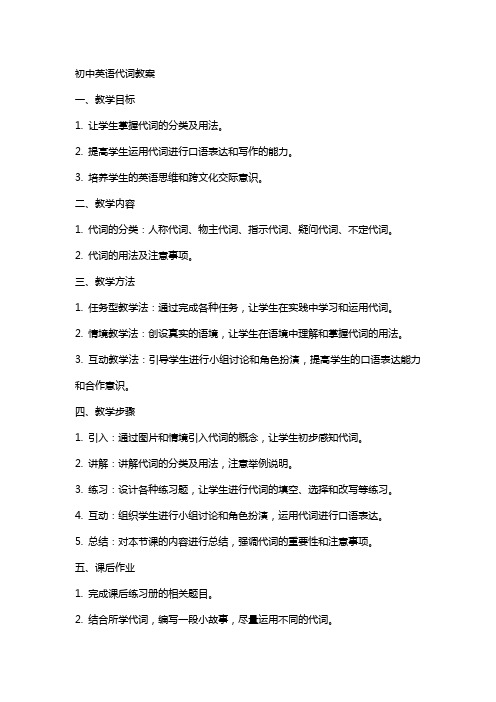
初中英语代词教案一、教学目标1. 让学生掌握代词的分类及用法。
2. 提高学生运用代词进行口语表达和写作的能力。
3. 培养学生的英语思维和跨文化交际意识。
二、教学内容1. 代词的分类:人称代词、物主代词、指示代词、疑问代词、不定代词。
2. 代词的用法及注意事项。
三、教学方法1. 任务型教学法:通过完成各种任务,让学生在实践中学习和运用代词。
2. 情境教学法:创设真实的语境,让学生在语境中理解和掌握代词的用法。
3. 互动教学法:引导学生进行小组讨论和角色扮演,提高学生的口语表达能力和合作意识。
四、教学步骤1. 引入:通过图片和情境引入代词的概念,让学生初步感知代词。
2. 讲解:讲解代词的分类及用法,注意举例说明。
3. 练习:设计各种练习题,让学生进行代词的填空、选择和改写等练习。
4. 互动:组织学生进行小组讨论和角色扮演,运用代词进行口语表达。
5. 总结:对本节课的内容进行总结,强调代词的重要性和注意事项。
五、课后作业1. 完成课后练习册的相关题目。
2. 结合所学代词,编写一段小故事,尽量运用不同的代词。
3. 预习下节课内容,准备进行课堂展示。
六、教学评价1. 课堂表现评价:观察学生在课堂上的参与程度、发言积极性和对问题的思考能力。
2. 练习完成情况评价:检查学生课后练习的完成质量,以及对代词用法的掌握程度。
3. 口语表达评价:评估学生在小组讨论和角色扮演中的口语表达能力和代词运用准确性。
七、教学拓展1. 举办代词知识竞答活动,激发学生的学习兴趣和竞争意识。
2. 组织学生进行代词主题的英语角活动,促进跨文化交流。
3. 推荐学生阅读代词相关的英语文章,提高学生的阅读理解能力。
八、教学资源1. 教材:选用合适的初中英语教材,如《新目标》、《人教版》等。
2. 图片:准备与代词相关的图片,用于引入和讲解。
3. 练习题:设计各类练习题,包括填空、选择、改写等。
4. 视频或音频材料:选用相关的英语视频或音频材料,辅助学生理解和学习代词。
初中英语代词教案
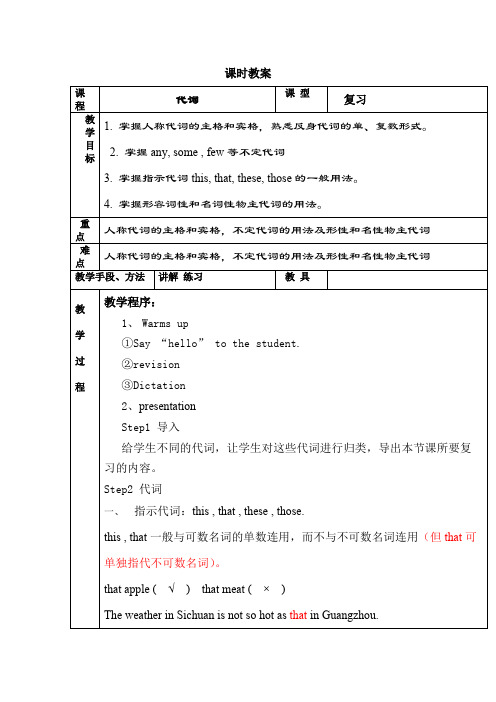
课时教案课程代词课型复习教学目标1. 掌握人称代词的主格和宾格,熟悉反身代词的单、复数形式。
2. 掌握any, some , few等不定代词3. 掌握指示代词this, that, these, those的一般用法。
4. 掌握形容词性和名词性物主代词的用法。
重点人称代词的主格和宾格,不定代词的用法及形性和名性物主代词难点人称代词的主格和宾格,不定代词的用法及形性和名性物主代词教学手段、方法讲解练习教具教学过程教学程序:1、Warms up①Say “hello” to the student.②revision③Dictation2、presentationStep1 导入给学生不同的代词,让学生对这些代词进行归类,导出本节课所要复习的内容。
Step2 代词一、指示代词:this , that , these , those.this , that一般与可数名词的单数连用,而不与不可数名词连用(但that可单独指代不可数名词)。
that apple ( √) that meat ( × )The weather in Sichuan is not so hot as that in Guangzhou.二、人称代词、物主代词和反身代词1)人称代词:主格、宾格(作主语为主格,作宾语为宾格; 动词+宾格;介+宾格)单数复数人称主格宾格主格宾格第一人称I me we us第二人称you you you youhe himthey themshe her第三人称it iteg. 1) I thank you2)You thank me.3) Give the book to me.2)物主代词:形容词性物主代词和名词性物主代词。
一变(my—mine); 二留(his—his its—its)三加s(your—yours ; our—ours ; her—hers ; their—theirs)用法:有名则形,无名则名。
人教版初二英语上册教案五篇

人教版初二英语上册教案五篇教学无止境,教案发展也无止境。
英语教案是教学设计的文本表现形式,是教师在整个教学过程中用来支撑课堂实践的理论基础。
下面就是小编整理的人教版初二英语上册教案,希望大家喜欢。
人教版初二英语上册教案1一、Teaching content:(教学内容)1.New words andphrases:hole,large,root,seedling,cover,fill,dirt,pack,dust,storm, dirty,northern,bottom, fill……with,by the way,dust storm,turn into,for sure,in thebottom of…2.Understand the meaning of text.3.Talking about how to plant a tree.二、Teaching goals:(教学目标)1.Master the new words and phrases,understand the meaning of text.2.Learn about how to plant a tree.3.Why we should plant trees?How to protect the environment in our dailylife?三、Key points:(重点)New words and phrases,the text.四、Difficult points:(难点)How to plant a tree?What are the basic steps for planting a tree?五、Teaching aids:(教学辅助) Recorder, pictures or cards.六、Type of the lesson:(课程类型) New lesson.七、Teaching procedure:(教学过程)Step 1.Analysis of the student.(学生分析)1.Greet the students in English and make sure they can responsecorrectly.Do the duty report: a student on duty can say whatever he/she likes tosay.2.Review:In last unit,we talked about the weather and spring,and we talkedabout some activities in spring,and we knew that,when we think of spring,wethink of a season of fresh air,we think of new life,green plants all aroundus.3.Review the grammar:Word building.Step 2. Lead in.(引入)Homework check.Come to “Think About It”When is Tree planting Day in China?What are the basic steps for planting a tree?Step 3. New lesson.(新课)No. 1 prepare lessons before class.Teach the new words and phrases.make sure the Ss can read it correctly.No. 2Text:Give them some time to read the text themselves. Then let them actout the dialogue in groups. Correct their pronunciation when necessary.At last,the teacher explain the text in Chinese,make sure the Ss canunderstand the meaning of text.No. 3Important sentences:It's also a great way to learn about nature.It's fun and important to plant plants.No. 4Word building:north →northern dirt →dirtyNo. 5 Finish “Let's Do It!”Step 4. Play the tape for the Ss to follow.Make the Ss listen the text,then let them read follow the tape.Step 5.Summary. (小结)Sum up the text what we learned,the new words,phrases,and sentences.Sum up the grammar.Step 6. Homework.(作业)Finish the activity book and the practice.Copy the new words and phrases twice.Step 7.Blackboard-writing:(板书)The new words,the master phrases,important sentences.The grammar and practice.八、Teaching reflection:(教后反思)人教版初二英语上册教案2一、Teaching content:(教学内容)1. New words andphrases:neither,nor,boot,jasmine,blossom,sunshine,TaiChi,swing,neither…nor,winter jasmine,play on the swing,a field trip.2. Understand the meaning oh text.二、Teaching goals:(教学目标)1. Master the new words and phrases,understand the meaning of text.2.Talking about the weather in spring and the temperature.3.Let Ss can describe outdoor activities in English.三、Key points:(重点)Talking about the weather in spring and the temperature.四、Difficult points:(难点)Let Ss can describe outdoor activities in English.五、Teaching aids:(教学辅助) Recorder, pictures or cards.六、Type of the lesson:(课程类型) New lesson.七、Teaching procedure:(教学过程)Step 1.Analysis of the student.(学生分析)Homework check.Review:In last lesson,we learned the weather in spring,and we can talk aboutthe weather report,we know a lot of things about spring,now we will learn someinteresting things in spring,and what do you know others about spring?Step 2. Lead in.(引入)1.Greet the students in English and make sure they can responsecorrectly.Do the duty report: a student on duty can say whatever he/she likes tosay.2.Think About It:What do you know about spring?Which season is your favourite?Step 3. New lesson.(新课)No. 1 prepare lessons before class.Teach the new words and phrases.make sure the Ss can read it correctly.No. 2Text:Give them some time to read the text themselves. Then let them actout the dialogue in groups. Correct their pronunciation when necessary.At last,the teacher explain the text in Chinese,make sure the Ss canunderstand the meaning of text.No. 3Important sentences:1.It's getting warmer.2.I need neither my heavy winter coat nor my boots now.neither…nor…表示“既不……也不……”。
代词的教案初中

代词的教案初中一、教学目标:1. 让学生掌握人称代词、物主代词、反身代词、指示代词和疑问代词的用法。
2. 培养学生正确运用代词进行交际的能力。
3. 提高学生对英语代词的认知水平和实际运用能力。
二、教学内容:1. 人称代词:I, you, he, she, it, we, they。
2. 物主代词:my, your, his, her, its, our, their。
3. 反身代词:myself, yourself, himself, herself, itself, ourselves, yourselves, themselves。
4. 指示代词:this, that, these, those。
5. 疑问代词:who, whom, whose, which, what。
三、教学步骤:1. 导入:通过图片和情境引入代词的概念,让学生初步了解代词的作用。
2. 讲解:详细讲解人称代词、物主代词、反身代词、指示代词和疑问代词的用法,并通过例句进行说明。
3. 练习:设计不同类型的练习题,让学生分组进行练习,巩固所学内容。
4. 交际:组织学生进行角色扮演和小组讨论,让学生在实际语境中运用代词。
5. 总结:对本节课的内容进行总结,强调代词的重要性和正确运用。
四、教学评价:1. 课堂参与度:观察学生在课堂上的积极参与情况和提问回答情况。
2. 练习完成情况:检查学生完成练习题的正确率。
3. 交际能力:评价学生在角色扮演和小组讨论中的表现。
4. 课后作业:布置相关作业,巩固所学内容。
五、教学资源:1. 图片:用于导入和讲解代词的概念。
2. 练习题:用于巩固所学内容。
3. 角色扮演和小组讨论:用于提高学生的交际能力。
4. 课后作业:用于巩固所学内容。
六、教学建议:1. 注重引导学生主动参与课堂,提高学生的积极性。
2. 多用例句和情境进行讲解,让学生更好地理解代词的用法。
3. 鼓励学生进行小组合作和角色扮演,提高学生的交际能力。
初中英语形容词性物主代词、名词性物主代词教案

初中英语形容词性物主代词、名词性物主代词教案一、教学目标1. 让学生掌握形容词性物主代词和名词性物主代词的用法。
2. 培养学生正确运用物主代词进行表达的能力。
3. 提高学生对英语物主代词的认知水平。
二、教学内容1. 形容词性物主代词:my, your, his, her, its, our, your, their。
2. 名词性物主代词:mine, yours, his, hers, its, ours, yours, theirs。
三、教学重点与难点1. 重点:形容词性物主代词和名词性物主代词的用法。
2. 难点:区分形容词性物主代词和名词性物主代词,以及它们与所修饰名词的possessive 关系的表达。
四、教学方法1. 采用直观演示法,通过实物、图片等展示物主代词的用法。
2. 采用情景教学法,设置生活场景,让学生在实际语境中运用物主代词。
3. 采用分组合作法,引导学生进行小组讨论和练习,提高学生的互动交流能力。
五、教学步骤1. 引入新课:通过展示一幅图片,引导学生观察图片中的物品,并提问:“这些物品是谁的?”引导学生回答:“This is my book.”引出物主代词的概念。
2. 讲解形容词性物主代词:介绍形容词性物主代词的构成及用法,如:“This is my book.”解释说明形容词性物主代词用于修饰名词,表示所有关系。
3. 讲解名词性物主代词:介绍名词性物主代词的构成及用法,如:“This book ismine.”解释说明名词性物主代词用于代替前面提到的名词,表示所属关系。
4. 举例练习:给出一些词语,如:“pen, book, chr, desk, car, house”等,让学生用形容词性物主代词和名词性物主代词进行搭配,如:“This is my pen.”、“The pen is mine.”5. 情景对话:设置一个生活场景,让学生运用形容词性物主代词和名词性物主代词进行对话,如:“A: Is this your book? B: Yes, it's mine. A: Can I borrow it? B: Sure, but please return it later.”6. 小组讨论:让学生分成小组,讨论生活中常见的物主代词用法,如:“We can use 'my' to indicate ownership, and 'yours' to refer to someone else's belongings.”7. 课堂小结:对本节课的内容进行总结,强调形容词性物主代词和名词性物主代词的用法及区别。
人教版八年级英语中的代词讲课教案

人教版八年级英语中的代词讲课教案一、选择题1.—Do you have ________else to say for your mistake?—________but sorry.A.anything; Something B.something; EverythingC.anything; Nothing D.something; Anything2.—Excuse me, I want to buy a birthday present for my younger sister.—OK. We have new kinds of toys for girls. You can choose for her.A.one B.it C.them D.that3.— Lucy, do you know whose wallet it is on the table?—Sorry, I don’t know. I asked many people, but ________ knew.A.nobody B.everybody C.anybody D.somebody 4.Online short video apps like Douyin make ________ more convenient to learn about the world at home.A.it B.this C.one D.that5.Robots are created by humans for humans. There’s ________ to be afraid of. A.something B.nothing C.everything D.anything 6.—Jack, you left your coat in the playground again?—It isn’t ________. Look, my coat is in my bag.A.mine B.my C.your D.yours 7.—Mom, I’d like to have a computer and a camera as my birthday present.—Well, you can have either of them. I’m afraid I can’t af ford ________.A.none B.all C.neither D.both8.We’d like to recommend Millie as the Young Star because of ________ effort and kindness. A.our B.ours C.her D.hers9.—This book on animals is interesting. I’d like ________. Where did you buy it, Simon?—In the bookshop near my school.A.it B.this C.that D.one10.To our sadness, an old man ________ in a wooden house. Nobody knew when he ________. But when I thought of his ________, I always feel pity.A.was found dead; died; death B.has dead; died; deathC.was found dead; death; dying D.has been dead; dying; died11.Jeff dreams of becoming a detective like Sherlock Homes. He thinks there is ________ more exciting than solving a mystery.A.everything B.something C.anything D.nothing12.—If you are buying today's Suzhou Daily, could you get ________ for me?—I'm glad to help you.A.it B.this C.one D.that 13.—Which of the two dresses will you choose for the party?—________ of them is suitable for a birthday party. They are too formal.A.Neither B.None C.Either D.Both14.My mother tried to cook ________ for me when I studied in New Zealand.A.different something B.different anything C.something different D.anything different 15.I can take good care of myself. I do not depend on ________.A.anybody B.everybody C.nothing D.something 16.It’s known to all that the Chinese are famous for ________ hard work and wisdom. A.they B.them C.their D.themselves 17.It’s very convenient ______ us to buy train tickets now because we can buy them either from the station or on the Internet.A.to B.of C.by D.for18.—Could you tell me how many classes you have on Friday afternoon?—___________. We can take part in activities in any club we like.A.None B.Nothing C.Neither D.Either 19.—Sam, there are so many spelling mistakes in your paper. You should try not torepeat________.—Sorry, Mr. White. I'll be more careful from now on.A.it B.its C.them D.theirs20.We couldn’t understand ________ because they were talking in Russian.A.they B.them C.their D.theirs 21.—Excuse me, I want to buy a birthday gift for my brother.—Here are some gifts for boys. You can choose ________ for him.A.it B.one C.that D.them 22.—Mary, is this ________ blue bike?—No, ________ is a black one.A.your; my B.your; mine C.yours; my D.yours; mine 23.— There are more TV series than before.—That’s true. But ________ was to my taste. I prefer westerns.A.all B.few C.some D.none24.My parents have made ________ a habit to go out for a walk around Xuanwu Lake.A.this B.it C.that D.one25.The new workshop can not only help students learn different skills but also teach _________ to care about others.A.they B.them C.their D.themselves 26.— When would you like to go to Nanjing Garden Expo (园博园) with me, this Friday or Saturday?— ________. I am free only this Sunday.A.Both B.None C.Neither D.Either27.My elder brother is creative, he is always full of ideas, but ________ is useful to my knowledge.A.neither B.nothing C.no one D.none28.Dora always comes up with new ideas, but ________ is of any value to me.A.none B.nothing C.no one D.neither29.—Do you know the percentage of the people who want to leave the Earth in China?—I think there is ________. In fact, there is ________ on other planets that can help people survive.A.nothing; none B.none; nothing C.nobody; none D.none; no one 30.As the old saying goes, politeness costs nothing and gains ________.A.nothing B.anything C.everything D.something 31.— Who was calling you on the phone just now?— ________ was my mum.A.She B.That C.It D.This 32.—Excuse me, is there a supermarket nearby?—I know ________. I will take you there.A.it B.one C.some D.that33.If something is wrong, fix it. Do not worry. Worry never fixes ________.A.something B.anything C.nothing D.everything 34.— Have you got any books on the differences between Chinese and Western festivals? I want to borrow one.— Yes, here you are. But you must return _______by Sunday.A.one B.it C.this D.that35.—He was the strong silent type.—Yes. He thought ________ better to say nothing.A.it B.its C.it’s D.itself36.—Can you play football or basketball?—________of them. I’m good at ball games.A.Both B.All C.Neither D.None37.—The apples are quite delicious! Can I have one more?—Sorry, there is ________ left, what about some oranges?A.none B.no one C.nothing D.nobody 38.—Which would you like to choose for your PE entrance exam, basketball or volleyball?—________. I prefer football.A.Both B.Either C.None D.Neither 39.—Where would you like to have a picnic, near Yangcheng Lake or in Forest Park?— ________ . You decide. I just want to relax myself in the beautiful nature.A.Either B.Neither C.Both D.None40.The sheep are eating grass on the hill. How happy ________ look!A.it B.its C.they D.them【参考答案】一、选择题1.C解析:C【详解】句意:——对于你的错误你还有什么要说的吗?——只有抱歉。
初中英语代词教案
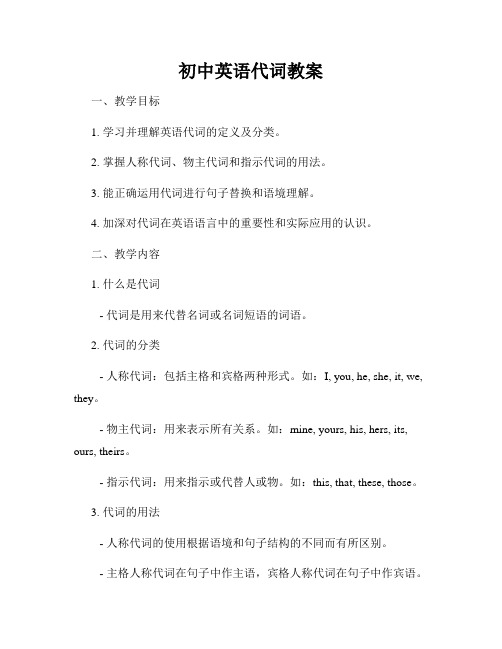
初中英语代词教案一、教学目标1. 学习并理解英语代词的定义及分类。
2. 掌握人称代词、物主代词和指示代词的用法。
3. 能正确运用代词进行句子替换和语境理解。
4. 加深对代词在英语语言中的重要性和实际应用的认识。
二、教学内容1. 什么是代词- 代词是用来代替名词或名词短语的词语。
2. 代词的分类- 人称代词:包括主格和宾格两种形式。
如:I, you, he, she, it, we, they。
- 物主代词:用来表示所有关系。
如:mine, yours, his, hers, its, ours, theirs。
- 指示代词:用来指示或代替人或物。
如:this, that, these, those。
3. 代词的用法- 人称代词的使用根据语境和句子结构的不同而有所区别。
- 主格人称代词在句子中作主语,宾格人称代词在句子中作宾语。
- 物主代词用来表示所属关系,放在名词前。
4. 代词的句子替换- 代词在句子中可以替代特定的名词或名词短语,使句子更加简洁明了。
- 通过使用代词,可以避免重复使用同一个名词,提高语言表达的效果。
三、教学过程1. 引入新知识- 教师向学生解释代词的概念和作用,引导学生思考代词的使用场景。
2. 学习人称代词- 教师逐一介绍人称代词的主格和宾格形式,并给出示例句子进行讲解。
3. 学习物主代词- 教师讲解物主代词的用法,并提供相关例句进行练习。
4. 学习指示代词- 教师介绍指示代词的使用场景和具体示范,让学生从中感受指示代词的功能。
5. 综合练习- 教师设计各种实际情境,提供句子并让学生使用适当的代词进行替换。
6. 总结归纳- 教师带领学生总结整个教学内容,检查学生对代词的掌握情况。
四、教学评价1. 口头评价- 教师随堂评价学生的参与度、表达能力和理解程度。
2. 书面评价- 教师布置相关作业,通过作业的完成情况评价学生对代词的灵活运用能力。
五、教学延伸1. 扩展练习- 学生可以观察周围环境,找出更多的句子并运用代词进行替换。
初中英语代词教案
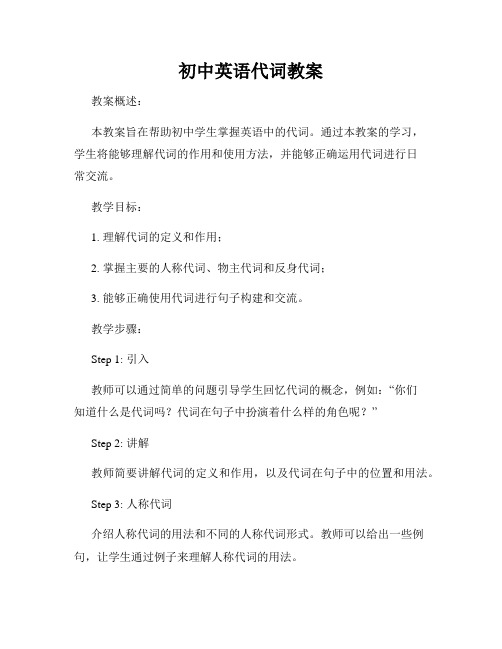
初中英语代词教案教案概述:本教案旨在帮助初中学生掌握英语中的代词。
通过本教案的学习,学生将能够理解代词的作用和使用方法,并能够正确运用代词进行日常交流。
教学目标:1. 理解代词的定义和作用;2. 掌握主要的人称代词、物主代词和反身代词;3. 能够正确使用代词进行句子构建和交流。
教学步骤:Step 1: 引入教师可以通过简单的问题引导学生回忆代词的概念,例如:“你们知道什么是代词吗?代词在句子中扮演着什么样的角色呢?”Step 2: 讲解教师简要讲解代词的定义和作用,以及代词在句子中的位置和用法。
Step 3: 人称代词介绍人称代词的用法和不同的人称代词形式。
教师可以给出一些例句,让学生通过例子来理解人称代词的用法。
Step 4: 物主代词介绍物主代词的用法和不同的物主代词形式。
教师可以给出一些例句,让学生通过例子来理解物主代词的用法。
Step 5: 反身代词介绍反身代词的用法和不同的反身代词形式。
教师可以给出一些例句,让学生通过例子来理解反身代词的用法。
Step 6: 练习提供一些练习题供学生进行巩固和练习。
教师可以设计填空题、选词填空或者改写句子等形式的练习进行训练。
Step 7: 拓展教师可以进一步扩展学生的知识,介绍其他类型的代词,如指示代词、疑问代词等,让学生了解更多关于代词的知识。
教学资源:1. PowerPoint课件或者白板;2. 练习题。
教学评估:教师可以通过课堂练习和口头问答评估学生对代词的掌握情况。
同时,可以布置一些家庭作业来巩固学生的学习成果。
教学延伸:1. 鼓励学生多阅读英语材料,注意观察和分析文章中的代词的用法;2. 教师可以设计更复杂的句子和练习,提高学生的代词运用能力;3. 引导学生学习更多关于代词的知识,包括代词的种类和用法。
教学反思:通过本教案的学习,学生将能够初步了解代词的概念和用法,并能够进行简单的代词运用。
教师需要有针对性地设计练习和扩展内容,确保学生牢固掌握代词的用法。
初中英语物主代词和指示代词教案

初中英语物主代词和指示代词教案一、教学目标:1. 理解并正确使用物主代词和指示代词。
2. 掌握物主代词和指示代词的形式和用法。
3. 能够在实际交际中正确运用物主代词和指示代词。
二、教学内容:1. 物主代词的形式和用法。
2. 指示代词的形式和用法。
三、教学过程:(注:请教师结合实际情况进行具体教学)Step 1: 导入新课1. 让学生提问并讨论:我们经常使用哪些代词?代词有什么作用?2. 引出本节课的教学内容——物主代词和指示代词。
简要介绍物主代词和指示代词的定义和作用。
Step 2: 学习物主代词1. 教师出示物主代词的表格,并向学生解释物主代词代表所属关系的含义。
2. 通过举例让学生理解和记忆物主代词的形式和用法。
3. 进行一些练习,确保学生掌握物主代词的使用。
Step 3: 学习指示代词1. 教师出示指示代词的表格,并向学生解释指示代词指示物体或事物位置的含义。
2. 通过举例让学生理解和记忆指示代词的形式和用法。
3. 进行一些练习,确保学生掌握指示代词的使用。
Step 4: 辨析物主代词和指示代词1. 教师出示一些句子,让学生辨析句中应该使用物主代词还是指示代词,并进行解释。
2. 引导学生思考和总结物主代词和指示代词的区别和相似之处。
Step 5: 情境操练1. 分组进行情景对话,要求学生在对话中使用物主代词和指示代词。
2. 学生互相提问关于物体或事物位置的问题,并使用适当的指示代词进行回答。
Step 6: 总结归纳1. 教师向学生总结物主代词和指示代词的重点内容,并进行梳理。
2. 确保学生对所学内容有一定的掌握,并解答他们可能存在的问题。
四、教学延伸:1. 教师可以设计一些扩展练习,帮助学生巩固所学的知识。
2. 鼓励学生在日常学习和交流中多使用物主代词和指示代词,提高运用能力。
五、教学反思:本节课通过结合实际情景和练习,使学生能够理解并正确使用物主代词和指示代词。
同时,通过情境操练,增强了学生的口语表达能力。
英语代词教案
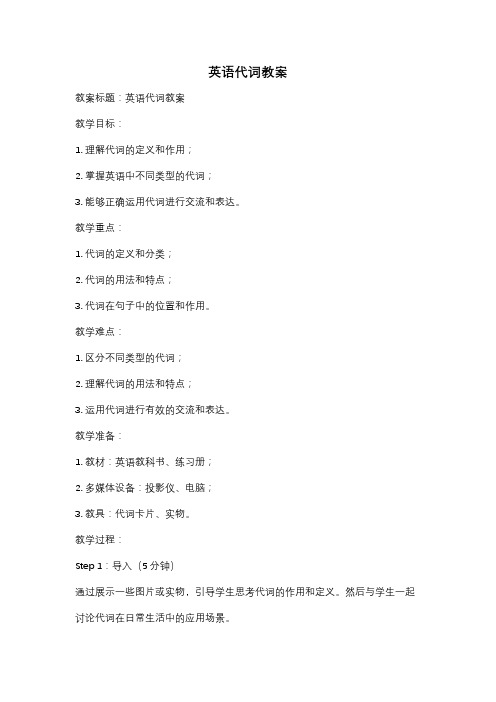
英语代词教案教案标题:英语代词教案教学目标:1. 理解代词的定义和作用;2. 掌握英语中不同类型的代词;3. 能够正确运用代词进行交流和表达。
教学重点:1. 代词的定义和分类;2. 代词的用法和特点;3. 代词在句子中的位置和作用。
教学难点:1. 区分不同类型的代词;2. 理解代词的用法和特点;3. 运用代词进行有效的交流和表达。
教学准备:1. 教材:英语教科书、练习册;2. 多媒体设备:投影仪、电脑;3. 教具:代词卡片、实物。
教学过程:Step 1:导入(5分钟)通过展示一些图片或实物,引导学生思考代词的作用和定义。
然后与学生一起讨论代词在日常生活中的应用场景。
Step 2:探究(15分钟)2.1. 引导学生观察和总结英语中常见的代词类型,如人称代词、物主代词、指示代词、疑问代词等。
通过多媒体展示相关的例子和用法,帮助学生理解不同类型代词的用法和特点。
2.2. 分组活动:将学生分成小组,每组给予一些代词卡片,要求学生根据卡片上的代词,用英语进行交流和描述。
老师可以在此过程中给予指导和反馈。
Step 3:讲解与练习(20分钟)3.1. 通过教科书或多媒体展示,详细讲解不同类型代词的用法和特点。
解释代词在句子中的位置和作用。
3.2. 给学生一些代词相关的练习题,让他们在课堂上完成并相互检查。
老师可以解答学生的疑问,并对练习结果给予评价和指导。
Step 4:拓展与运用(15分钟)4.1. 给学生提供一些真实情境,要求他们运用代词进行口头或书面表达。
例如,描述自己的家庭成员、介绍自己的朋友等。
4.2. 学生分组进行角色扮演,模拟真实场景,运用代词进行对话和交流。
老师可以提供一些情境提示和对话模板。
Step 5:总结与评价(5分钟)与学生一起总结本节课所学的内容,并进行简单的评价。
鼓励学生提出问题和反馈意见。
教学延伸:1. 布置相关的家庭作业,巩固学生对代词的理解和运用;2. 鼓励学生在日常生活中积极运用代词,提高语言表达能力;3. 可以在后续课堂中引入更复杂的代词用法和相关知识。
- 1、下载文档前请自行甄别文档内容的完整性,平台不提供额外的编辑、内容补充、找答案等附加服务。
- 2、"仅部分预览"的文档,不可在线预览部分如存在完整性等问题,可反馈申请退款(可完整预览的文档不适用该条件!)。
- 3、如文档侵犯您的权益,请联系客服反馈,我们会尽快为您处理(人工客服工作时间:9:00-18:30)。
一、教学内容:代词二、教学目标:通过本讲的学习,使学生进一步清楚地了解到代词间脉络关系,更好地掌握代词的用法。
三、教学重点:代词的基础知识及其运用四、本讲的重点知识讲解:2. 指示代词指示代词包括:this, that, these, those指示代词在句中可作主语、宾语、表语、定语,例如:①This is an interesting book. Please read it carefully.(主语)②We have made class rules. We should always keep these in mind.(宾语)③My idea is this.(表语)④Those students are from Australia. They can speak English.(定语)3. 疑问代词:疑问代词包括:who, whom, whose, what和which.其中who用来作主语和表语,例如:Who is speaking?(主语)Who are you?(表语)whom作宾语Whom are you going to Beijing with?(宾语)whose, what和which可以作主语、表语、宾语和定语.①Whose book is this? It’s Tom’s.(定语)②Whose is this car? It’s Mr. Wang’s.(表语)③Whose is better? Tom’s or Jim’s?(主语)④What do you have for breakfast?(宾语)4. 不定代词:不定代词包括:all, each, every, both, one, little, few, many, much, other, another, some, any, no,还有由some, any, no和every构成的合成词。
如:something, anything, nothing, everything, somebody, anybody, nobody和everybody等。
不定代词中,多数都能作主语、宾语、表语或定语,但含有some, any, no, every的合成词只能作主语、宾语、表语,而every和no只能作定语。
【典型例题】1. As we all have grown up. We should learn to look after .A. ourselvesB. usC. myselfD. me2. —Which tie is more suitable for me, the red one or the blue one?—I have no idea. You’d better take them.A. allB. eachC. everyD. both3. —Do you want tea or coffee?—. I really don’t mind.A. BothB. NoneC. EitherD. Neither4. —Who is the boy over there?—is our monitor.A. HeB. HisC. HimD. Himself5. Look! There are pictures on the left wall.A. anyB. someC. muchD. both6. —Who is singing in the classroom?—must be Susan.A. SheB. ItC. ThisD. He7. —Do you know about David?—Yes, I know very well.A. heB. himC. himselfD. his8. It rained heavily this morning, but of my classmates were late for school.A. neitherB. noneC. allD. nor9. There is for you if you put your heart into it.A. difficult nothingB. nothing easyC. nothing difficultD. nothing easy10. —Do you need any milk?—No, I have got bottles in the refrigerator.A. fewB. a fewC. littleD. a little11. —Can you hear the strange noise from the washing machine?—must be wrong with it.A. AnythingB. NothingC. SomethingD. Everything12. My parents and I couldn’t ge t into the house because of us had a key.A. allB. neitherC. anyD. none13. —What’s on TV tonight?—There’s . It’s boring.A. something interestingB. anything interestingC. everything interestingD. nothing interesting14. —Would you like some water or tea?—. A cup of coffee, please.A. NeitherB. BothC. EitherD. None15. Jimmy’s parents are teachers, of them teaches Chinese. They both teach French.A. NeitherB. BothC. EitherD. None16. Most young people find exciting to watch a football match.A. itB. thisC. thatD. one17. My uncle has two children. But of them lives with him.A. eachB. neitherC. eitherD. both18. —Wow, so many new houses! I can’t believe that. It u sed to be a poor village.—Yes. has changed here.A. NothingB. SomethingC. EverythingD. Anything【模拟试题】(答题时间:70分钟)Ⅰ. 用所给词的适当形式填空:**1. As we all have grown up, we should learn to look after (we).2. —Do you know about David?—Yes, I know (he) very well.*3. Bill is in the classroom, doing (he) homework.**4. This car is much more expensive than (I).*5. Help (you) to some apples, children please.Ⅱ. 单项选择:**1. We need some more coffee. There is only left. It’s not enough, I’m afraid.A. littleB. a littleC. fewD. a few**2. —Who will teach you to swim this summer?—The twins. Because Lily Lucy swim very well.A. both, andB. neither, norC. either, orD. not only…but also3. is difficult for you if you put your heart into it.A. EverythingB. SomethingC. NothingD. Anything*4. The parents always leave the little dog alone at home. They think that it is old enough to look after .A. itB. itselfC. themD. themselves*5. —What’s on TV tonight? Is there interesting?—I’m afraid not.A. somethingB. anythingC. nothingD. everything**6. is watching TV. Let’s turn it off.A. SomebodyB. AnybodyC. NobodyD. Everybody**7. My cousin is very busy with his work. He has time to read newspaper.A. littleB. fewC. a littleD. a few**8. We had a picnic last term and it had a lot of fun, so let’s have one this month.A. the otherB. someC. anotherD. other9. —Have you got my e-mail today?—Oh, there’s wrong with my computer. It doesn’t work.A. somethingB. anythingC. nothingD. everything**10. —The box looks so big. Can I help you?—No, thanks. in it. It’s empty.A. NothingB. EverythingC. AnythingD. Something11. There is in it, it’s quite light.A. nothingB. anythingC. everythingD. something**12. —Do you need any milk? —No, I have got bottles in the refrigerator.A. fewB. a fewC. littleD. a little**13. There is for you if you put your heart into it.A. difficult nothingB. nothing easyC. nothing difficultD. easy nothing**14. —Wow! So many new houses! I can’t believe that. It used to be a poor vi llage.—Yes, has changed here.A. NothingB. SomethingC. EverythingD. Anything**15. —Would you like some water or tea?—. A cup of coffee, please.A. NeitherB. BothC. EitherD. NoneⅢ. 完形填空An accidentI was riding my motorbike along a country road near Chilton on the evening of February 15. I1 it was about 9:30. It was2 and I couldn’t see things clearly. So I was driving very3 , but the road was bad and suddenly my bike4 a stone, and before I could stop my bike. I was already5 on the ground. My whole6 hurt, especially(特别)my left arm.I knew I was bleeding(流血), and I 7 get up. Luckily I was 8 by a policeman. He madea telephone call and I was taken to the 9 . There I was examined. I had a broken arm and lots of cuts. My arm was put in a cast(石膏绷带)and my cuts were 10 and bandaged(包扎).1. A. told B. said C. guess D. thought2. A. dark B. far C. long D. later3. A. fast B. well C. carefully D. carelessly4. A. kicked B. hit C. beat D. touched5. standing B. sleeping C. waiting D. lying6. A. mind B. body C. head D. arm7. A. couldn’t B. didn’t C. wouldn’t D. might not8. A. caught B. held C. led D. found9. A. police station B. village C. doctor D. hospital10. A. stopped B. repaired C. served D. cleanedⅣ. 阅读理解AOnce there lived an old man in a town. He always forgot a lot of things. So his wife always had to say to him, “Don’t forget this.”One day he went on a long way alone. Before he left home, his wife said, “Now you have all these things. You nee d them on your way. Take care of your things on the way.” He went to the station. He bought a ticket and got on the train with it.About an hour later, the conductor began to see the tickets. He came to the old man and said, “Will you please show me your ticket?” The old man looked for his ticket in all his pockets but he could not find it. He was very worried. “I can’t find my ticket. I really bought a ticket before I got on the train, ” said the old man.“I think you are right. I believe you bought a ticket. All right, you don’t have to buy another ticket,” said the conductor kindly. But the old man still(仍然) looked worried and said sadly, “You don’t know why I’m worried. If I don’t find my ticket, I can’t remember my station. Where am I going?”根据短文内容,选择正确答案。
